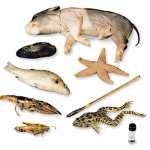Zoology
|
30 march 2015 09:48:16 |
| Comparison of recording of pericarditis and lung disorders at routine meat inspection with findings at systematic health monitoring in Danish finisher pigs (Acta Veterinaria Scandinavica) |
|
Tweet Background:
The use of secondary data is widespread in a range of surveillance and monitoring applications because of the low cost and high availability associated with this form of data. However, as they are often collected for quite unrelated purposes, they are not necessarily fit for the new purpose that is required of them. Routine meat inspection data were originally collected with the purpose of safeguarding food, but have been re-tasked to also include animal welfare assessment. The objective of the present study was to compare the recording of pericarditis, pleuritis and lungs with lesions at routine meat inspection (RMI) with those performed at systematic health monitoring (SHM) in Danish pigs at slaughter, in order to assess the usefulness of RMI for monitoring the prevalence of these diseases. Data originating from 165 Danish pig herds were collected in the period September 2011 to November 2013. From each herd, a batch consisting of all pigs slaughtered on a specific day from a specific farm were included as the RMI data, while lungs and hearts sampled from the batches were used for the SHM. The RMI data and SHM data included recordings related to a) chronic pericarditis, b) chronic pleuritis and c) lung lesions. The proportion of carcases with a specific disease recording was estimated for each batch of pigs, and linear regression was used to relate the RMI-proportion to the SHM-proportion for the conditions mentioned above.
Results:
The coefficients of determination (R2) were estimated as R2
,pericarditis = 0.16; R2
,pleuritis = 0.67; R2
,lungs with lesions = 0.40. R2
,pericarditis changed to 0.42 when the regression analysis included inspection type at the abattoir (with purely visual inspection of the hearts versus traditional inspection including an incision into the heart).
Conclusions:
Overall, the results suggest that the correlation between findings at RMI and SHM was moderate for pleuritis and lungs with lesions, but poor for pericarditis. The latter could partly be explained by the type of meat inspection conducted at the abattoir. We conclude that caution should be used whenever RMI data are used for purposes other than those for which they were originally intended. |
| 91 viewsCategory: Medicine, Zoology |
 Spatial characterization of colonies of the flying fox bat, a carrier of Nipah Virus in Thailand (BMC Veterinary Research) Spatial characterization of colonies of the flying fox bat, a carrier of Nipah Virus in Thailand (BMC Veterinary Research)Refinement and partial validation of the UNESP-Botucatu multidimensional composite pain scale for assessing postoperative pain in horses (BMC Veterinary Research) 
|
| blog comments powered by Disqus |
MyJournals.org
The latest issues of all your favorite science journals on one page
The latest issues of all your favorite science journals on one page



